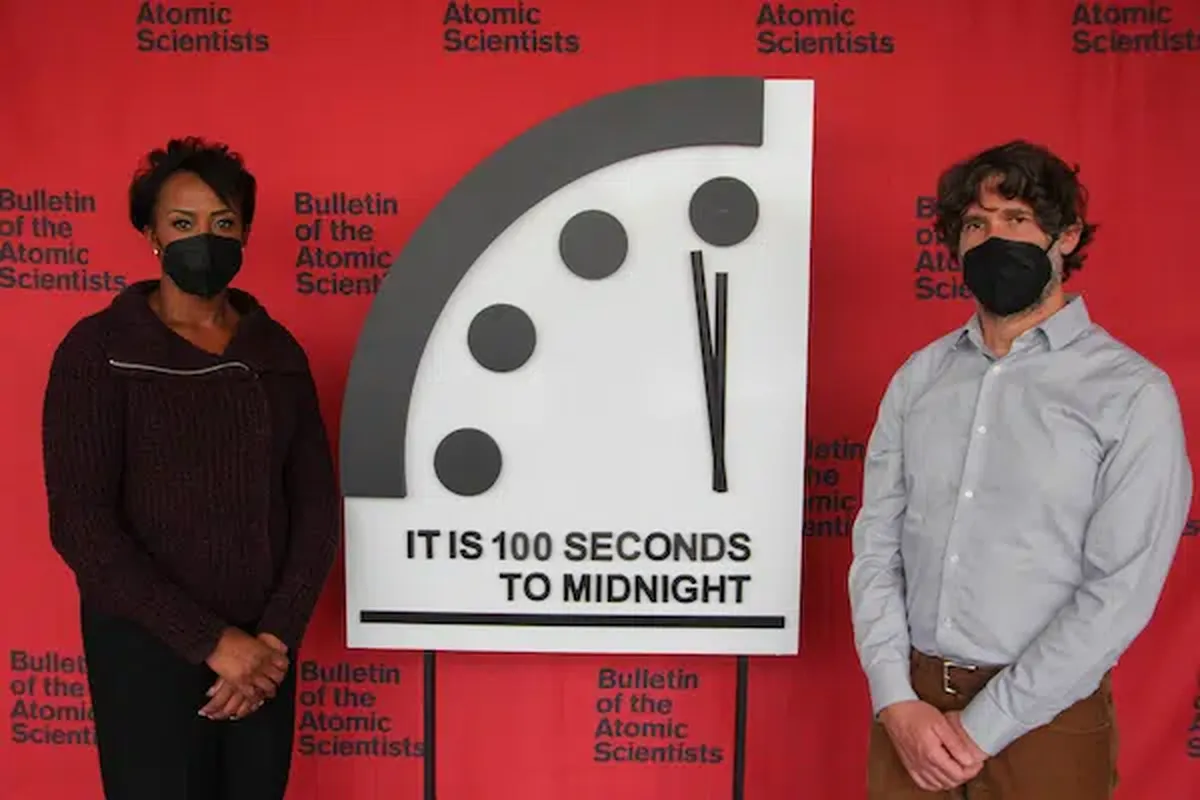75 years ago, members of the Manhattan Project, created for the development of nuclear weapons, created the
Bulletin of Atomic Scientists
, the publication of a group that aims to alert the public, policymakers and scientists of the threats to humanity that this generates As a metaphor, every year they adjust an imaginary doomsday
clock
based on the risks created by nuclear weapons, climate change and disruptive technologies. This Thursday they have kept it at 100 seconds from midnight, symbolic time of the apocalypse. For this year's guest science communicator, Hank Green, “it's not good news”.
Rachel Bronson, president and CEO of the
Bulletin of Atomic Scientists
, has insisted on this idea: “The clock continues to remind us how much work needs to be done to ensure a safer and healthier planet.
We must continue to move the hands of the clock away from midnight.”
The co-chair of the group's Science and Security Board and a research professor at the George Washington University's Institute for International Science and Technology Policy, also lamented having to keep time to midnight: "One hundred seconds reflects that we're stuck at a dangerous time, one that brings neither stability nor security.
The positive developments in 2021 could not offset the long-term negative trends.”
The danger of invasion of Ukraine by Russia has been one of the elements included in the forecast. Attempts to dissuade Putin from military intervention have become the main objective of Western powers. However, as NATO Secretary General Jens Stoltenberg stressed on Tuesday in Berlin: "The risk of a conflict is real." Added to this risk are tensions with China, Venezuela and North Korea. For political science professor Scott D. Sagan, "the signs of new arms races are clear."
Also the environmental crisis generated by climate change. Raymond Pierrehumbert, a member of the
Bulletin
and professor of physics at Oxford, has pointed out how half a century ago the warnings about the crisis generated by global warming began. “No progress has been made”, he assured before demanding immediate and concrete actions. “All is not lost,” he has said.
On disruptive technologies, Green has highlighted the change generated in the field of communication and has described it as "a monkey with a gun". The popularizer has urged to waste less time getting angry and more time being curious, to "work together to save the world". Precisely, on the occasion of the 75th anniversary of the clock, the
Bulletin
has requested the collaboration of the population with the campaign #TurnBackTheClock (turn back the clock). The challenge encourages people to use social media to share stories about actions that inspire them and strategies on how to avoid the ultimate crash.
Herb Lin, a senior fellow in cybersecurity and policy at Stanford University, has elaborated on Grenn's warnings: "Technology has contributed mightily to an environment in which no conceivable evidence or rational argument can persuade true believers to change." of opinion, and the resulting fractures in our common understanding of what is true translate into a nation sharply divided against itself.”
biological threats
Last year, the clock stopped 100 seconds from the end of the world, the closest mark of the apocalypse, which is repeated this year. In 2021, it remained at the time set a year earlier, despite the effects of the coronavirus pandemic. According to the president of the Bulletin, Rachel Bronson, the crisis created by this disease has been "a vivid illustration that national governments and international organizations are not prepared to handle the threats that truly end civilization." However, it was not enough to advance the symbolic clock. According to Bronson, "Covid will not eliminate humanity, but it is a clear example that the authorities around the planet are not capable of facing global dangers."
In this sense, the scientist Asha M. George, also a member of the committee, recalled this Thursday the global response with vaccines and urged to continue fighting against global dangers to health, as has been done with other diseases, but has warned: “We can no longer afford to focus all our efforts on other hazards to the exclusion of the biological threat. If we do, the diseases and lives taken will push the second hand closer to midnight."
The clock started ticking when the nuclear detonations began, in the middle of the last century.
It is the date with the most consensus for the origin of the Anthropocene, the geological epoch marked by the global impact of human activities.
The missile crisis placed the hands very close to the end of the world.
However, in the 1990s, after the Strategic Arms Reduction Treaty was signed between the US and Russia, the clock was delayed to 17 minutes, the furthest time from the end of humanity in all these years.
In 2007, climate change was included as a serious danger to humanity that demands an “urgent and immediate” response.
Since then, the hand of the clock has not stopped approaching the symbolic midnight.
The
clock of the final judgment
or
the end of the world
does not refer to a specific time corresponding to years or decades.
This symbolic stopwatch is not intended to be so much an omen of self-annihilation as a wake-up call to reverse the direction of the handles towards models that are less harmful to society and the planet.
It is adjusted each year by the Bulletin's Science and Safety Board after consultation with the organization's sponsors.
Among the members are more than a dozen Nobel Prize winners.
You can follow MATERIA on
,
and
, or sign up here to receive
our weekly newsletter
.














